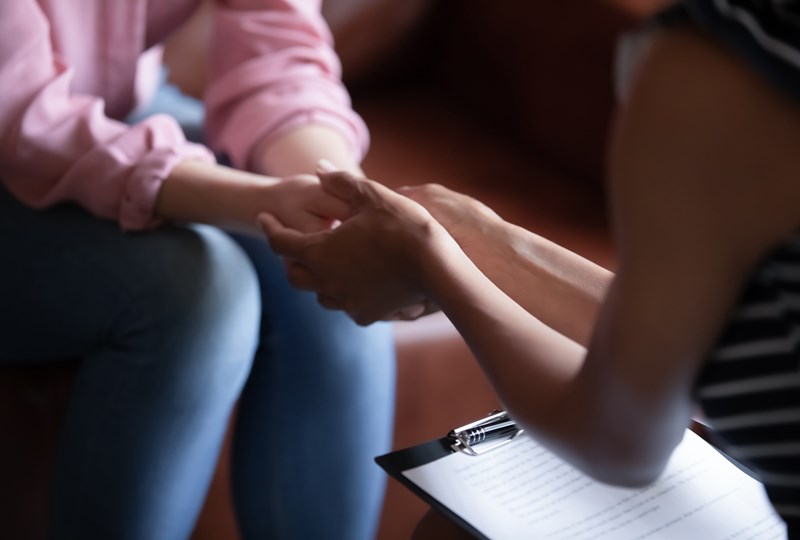Domestic abuse and coercive control
We define domestic abuse as an incident or pattern of incidents of controlling, coercive, threatening, degrading and violent behaviour, including sexual violence, in the majority of cases by a partner or ex-partner, but also by a family member or carer.
If you or anyone you know is experiencing domestic abuse, please see a list of resources and organisations here.
The RCM and Cavell Nurses' Trust have set up the Benevolent Fund to support midwives and maternity support workers (MSWs) who are facing domestic abuse or coercive control and needing to flee. Apply for the Benevolent Fund here.
For 16 Days of Activism this year's theme is Push Forward. Watch this year's film from The United Nations Entity for Gender Equality and the Empowerment of Women (UN Women):
The RCM has also updated its i-learn module on domestic abuse and how members can support the women and families in their care:

Complete the i-learn module on domestic abuse
Learn moreCoercive control is controlling behaviour described as a range of acts designed to make a person subordinate and/or dependent, by isolating them from sources of support, This can involve exploiting their resources and capacities for personal gain, depriving them of the means needed for independence, resistance and escape and regulating their everyday behaviour (Home Office, 2013).
Coercive behaviour is an act or a pattern of acts of assault, threats, humiliation and intimidation as well as other abuse that is used to harm, punish, or frighten their victim (Home Office, 2013).
Coercive control is an act, or a pattern of acts of threats, humiliation, degradation, intimidation, or other abuses used by a perpetrator(s)/abuser(s) to frighten, punish, or harm the victim and involves ongoing degradation and frightening threats.
It is designed by an abuser(s) to keep the victim subordinate, entrapped, and isolate them from family and friends and other support networks, exploit them, deprive them of independence and regulate their everyday behaviour, such as in the following examples:
- Deprivation of liberty, autonomy, and the freedom to act in own interest
- Controlling interactions with family and friends
- Depriving victims of access to support or healthcare or speaking to agencies
- Monitoring and tracking emails, phone calls and conversations
- Controlling the use of social media and technology
- ‘Love bombing’ – over-expression of love
- Financial abuse
- Threats to victims or loved ones; threats to destroy personal possessions
- Sexual coercion and abuse
- Use of violence to ensure compliance.
Contextualising abuse within customs and cultural norms.
Female child victims of coercive control behaviours can experience all the associated threats of coercive control. However, victims of Child Marriage and Female Genital Mutilation are usually coerced and controlled through bribery, and false narratives about the benefits of the abuse. They sometimes experience over-expressive parental/familial love and are sometimes sworn to secrecy in order to protect the family name and honour.
Who is affected/who is at risk of coercive control?
Mainly women, children and vulnerable individuals including pregnant women. Important to note that, although coercive controlling behaviour is predominantly perpetrated against girls and women, boys and men can also fall victim to this behaviour. For example, a pregnant woman could be a coercive or controlling partner. Midwives need to be aware of how this manifests, particularly where there are other children in the family who may display traits of this abuse.
Is coercive controlling behaviour a crime?
Yes, it is criminalised under the offence of coercive and controlling behaviour - Section 68 of the Domestic Abuse Act (Domestic Abuse Act, 2021) , even if they are in an intimate personal relationship, they live together, are members of the same family, or previously have been in an intimate personal relationship.
What should I be looking for/how does a victim of coercive controlling behaviour present?
- Is the woman always accompanied to appointments?
- Does the partner/family member always speak on their behalf, and arrange their appointments even when there are no language barriers?
- Is she often fearful to speak or express an opinion for fear of threats to herself or loved ones (direct or indirect threats)?
- Does she display disempowerment and an inability to make her own decisions?
- Is she dependent on the abuser for financial support, housing, childcare or in some cases immigration status?
- Does she appear to severely lack confidence, low self-esteem or self-worth?
- Does she say/feel she is to blame or make excuses for the abuser?
- Does she appear/tell you she is stressed or has bouts of depression?
- Is there evidence or indication of alcohol or substance misuse?
Important to Note
Coercive controlling behaviour may not result in physical violence or leave visible marks on the victim; the bruises and marks are psychological and mental scars, especially if the behaviour is repeated over time. Coercive control is the springboard for all subsequent abuse and violence against women and girls.
How should I respond if someone (patient/colleague) describes/displays coercive control?
Your response should be the same as for all cases of suspected or actual domestic abuse or violence against women and girls.
Ask direct questions such as:
- Do you have family/friends nearby and are you able to contact them easily?
- Does your partner/family member prevent you from contacting friends/family?
- Do you feel that you are deprived of basic needs, such as food?
- Are you able to leave your house to go to work or college?
- Does your partner or family control your everyday life, such as where you can go, whom you can see and when you can sleep?
- Are you allowed to use your mobile phone as and when you wish?
- Are you allowed to go out to do simple things like shopping?
- Do you choose what you wear or how you dress?
- Does your partner or family monitor the time you spend away from home?
- Does your partner or family spy on you?
- Are you prevented from seeing your midwife or GP on your own?
- Are you forced to have sex with someone who is not your partner?
- Does your partner or family member repeatedly put you down, or tell you that you are worthless?
- Do you feel humiliated, degraded or less of a person?
- Does your partner/family member control your finances?
- Does your partner or family member threaten or intimidate you?
- Do you feel isolated from your family and friends?
- Do you have bruises, burns or bite marks anywhere on your body?
- Does your partner or family monitor your use of the internet or social media?
- Does your partner or family read your texts, emails or letters?
- Are you repeatedly belittled, put down or told you are worthless?
- Are you pressured into having sex or into having sexual contact with someone that Is not your partner?
- Does your partner or family ‘Gaslight’[i] you - telling you that the abuse is your fault, or that you’re overreacting?
Dos
- Listen without judgement
- Reassure her that you believe her, and validate her narrative
- Explain to her that coercive control is abuse, even if she has not experienced physical violence
- Refer her to credible sources of support with her consent/if she wants to be referred
- Document clearly in her notes.
Don’ts
- Don’t blame the woman or minimise her experience
- Don’t encourage her to leave unless she discloses that there is a safety plan in place
- Don’t use your own experience to advise her
- Don’t record your discussion with the woman in her handheld notes.
Being aware
Be vigilant of smart speakers that have ‘listening in’ functions when in clients’ homes.
If you become triggered by any aspect of the discussion, seek help for yourself and consider referring the woman to someone else.
Gaslighting is emotional abuse and a subtle form of psychological abuse and manipulation that can destroy a victim’s confidence, leaving them feeling extremely vulnerable. It can make the victims doubt themselves, their memories, and their judgement, and it has a devastating impact on their mental health and wellbeing. Gaslighting can also be described as a manipulative power game and insidious deceptive behaviour.
National Domestic Abuse Helpline - 0808 2000 247 or webchat (3pm-10pm Mon-Friday).
National LGBT+ Domestic Abuse Helpline – 0800 999 5428
Rape Crisis services - 0808 802 9999 – or webchat
Women’s Aid webchat https://chat.womensaid.org.uk/ [Available Monday 10am -12pm]
Iranian and Kurdish Women’s Rights Organisation – http://www.ikwro.org.uk/, 0207 920 6460
Karma Nirvana – https://karmanirvana.org.uk/ 0800 5999247 or 01332 604098
The Sharan Project https://sharan.org.uk/services-resources/for-professionals/
Southall Black Sisters https://southallblacksisters.org.uk/
Women’s Aid safety and support resources (multiple languages and sign language) https://www.womensaid.org.uk/covid-19-coronavirus-safety-and-support-resources/
Refresh your knowledge with RCM i-learn https://www.ilearn.rcm.org.uk/course/info.php?id=633
Brief guidance for safe enquiry about domestic abuse https://safelives.org.uk/sites/default/files/resources/Domestic%20abuse%20guidance%20for%20virtual%20health%20settings-%20C19.pdf
Department of Health and Social Care - Responding to domestic abuse. A resource for health professionals (go to p28) https://assets.publishing.service.gov.uk/government/uploads/system/uploads/attachment_data/file/597435/DometicAbuseGuidance.pdf
Barlow C, Johnson K, Walklate S (2018). Coercive Control cases have doubled - but police still miss patterns of domestic abuse. The Conversation. http://clok.uclan.ac.uk/39833/ [Accessed 21 November 2022].
Domestic Abuse Act 2021 (c.17). London: The Stationery Office. https://www.legislation.gov.uk/ukpga/2021/17/contents/enacted [Accessed 21 November 2022].
Home Office (2013). Information for Local Areas on the Change to the Definition of Domestic Violence and Abuse. London: Home Office. https://assets.publishing.service.gov.uk/government/uploads/system/uploads/attachment_data/file/142701/guide-on-definition-of-dv.pdf [Accessed 21 November 2022].
Myhill A, Hohl K (2019). The "Golden Thread": Coercive Control and Risk Assessment for Domestic Violence. Journal of Interpersonal Violence 34(21-22):4477-97.
Stark E, Hester M (2019). Coercive Control: Update and Review. Violence against Women 25(1):81-104. https://doi.org/10.2989/16085906.2022.2073897 [Accessed 21 November 2022].
Walklate S, Fitz-Gibbon K (2019). The Criminalisation of Coercive Control: The Power of Law? International Journal for Crime, Justice and Social Democracy 8(4):94-108. https://doi.org/10.5204/ijcjsd.v8i4.1205 [Accessed 21 November 2022].
